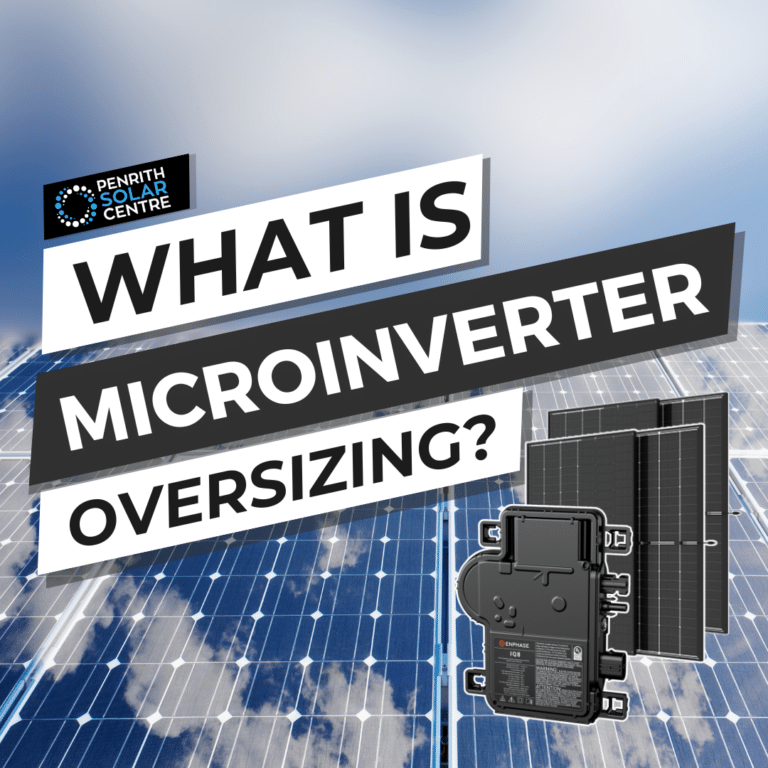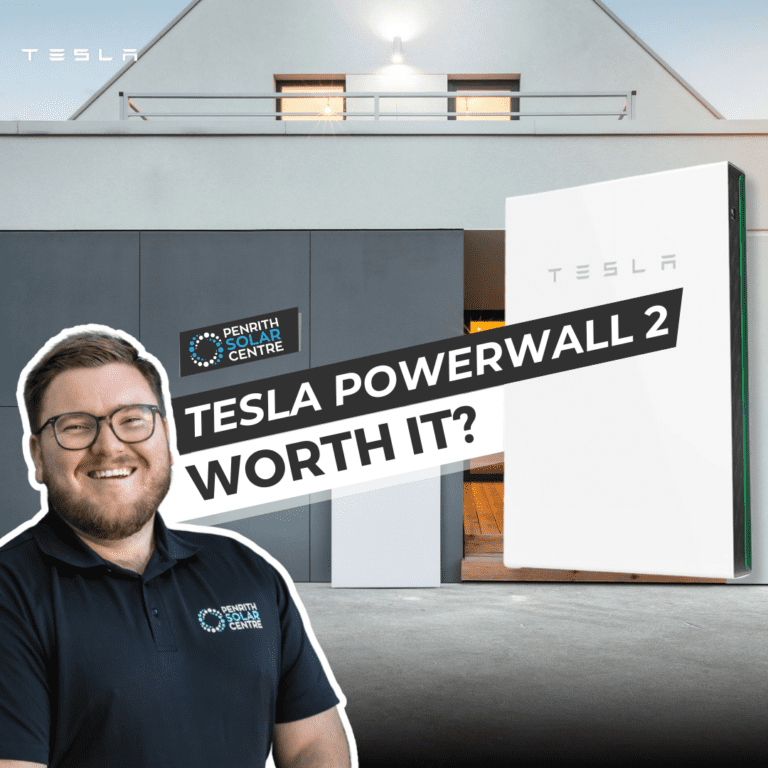As you progress along your solar journey, you’ve probably discovered the heated debate between string inverter solar systems and microinverter solar systems. Lines in the sand have been drawn, families have been separated, and you and your solar investment are caught in the middle. And the only question you still have is this: are they worth it?
At Penrith Solar Centre, we exclusively install microinverter solar systems. We are biased when it comes to the great string inverter versus microinverter debate. We believe in our product and in providing you with peace of mind for your home.
However, we also want you to install the best solar system for your needs. In that spirit, we will be as absolutely unbiased as we can.
In this article, you will learn:
- What Do String Inverters Do?
- Questions to Ask Yourself When Speaking with a String Inverter Sales Company
- Do I Need Microinverters If I Don’t Have Shading?
- Are String Inverters as Efficient as Microinverters?
- Do String Inverters or Microinverters Have a Longer Payback Period?
- Timeline of a Faulty String System
By the end of this article, you’ll understand the difficulties you might face by choosing a string inverter solar system.
What Do String Inverters Do?
String inverters and microinverters perform the same task in a solar system: they convert the type of electricity harvested by the solar panels into electricity the house can use to run appliances.
In a string inverter solar system, the inverter (which converts direct current (DC) to alternating current (AC)) is located on the side of the house. From there, it’s redirected to the main switchboard and sent to the home, or a battery (if you have one), or the grid for a feed-in tariff.
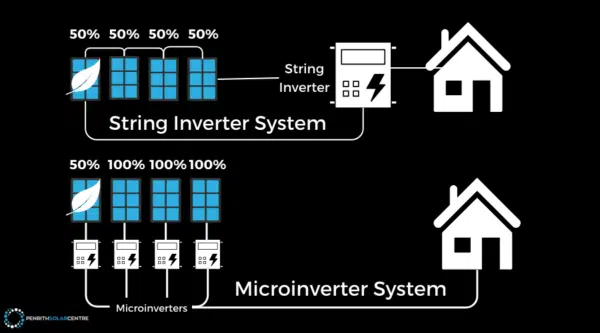
In a microinverter solar system, individual microinverters (which convert DC to AC power as well) are mounted underneath each solar panel on the roof. It immediately converts the power before sending it to the iBoard (or Controller, depending on whether you have a battery or not), then the main switchboard, and then the home, or a battery, or the grid.
We install microinverter systems for so many different reasons, some of which we’ll get into, but to understand the in-depth mechanics of how these two types of technology are similar and different, you might want to check out the following article on that very topic titled, Microinverters vs. String Inverters: An Honest Comparison. It’s one of our most popular articles on the topic and it’s full of great information.
We like micros, but string systems can perform well and cut down those energy bills. They can be great systems. They just don’t last very long.
Questions to Ask Yourself When Speaking with a String Inverter Sales Company
The unfortunate reality is that there’s a lot of misinformation about microinverters versus string inverter solar systems. We have discovered that companies selling string inverter solar systems leave a vacuum of misinformation about microinverters with customers. They don’t sell microinverters, so how much could they know about them?
When speaking with a sales consultant from one of these companies, listen when you ask them about microinverters:
- Are they brushing over it quickly? Offering you a few fast and loose opinions that are posed as facts?
- Does any of it sound well-researched?
- Are they explaining how microinverters work?
Why would you trust a sales representative who doesn’t understand how their competition’s product works?
Do I Need Microinverters If I Don’t Have Shading?
A common misconception about microinverter solar systems is that you don’t need them unless you have shading on your roof. It makes sense that you would want to save money on a system if you don’t have shading. You don’t want any obstructions from trees or nearby buildings keeping your solar panels from soaking up that sweet, sweet sunshine.
But what about a cloudy day? Your system is shaded from the sun then. What about debris blown onto your solar panels? That would get in the way of the panel producing its promised power (say that five times fast). Leaves and trash and bird faeces and all kinds of dust and other things can block the whole panel from receiving sunlight. On every roof, on every home in Australia.
If you’re interested in learning more about common misconceptions about microinverters, you might want to check out the following article titled, Myths & Misconceptions About Solar Microinverters.
Are String Inverters as Efficient as Microinverters?
The solar panels in a microinverter solar system each operate independently from each other in harvesting and exporting power to the home. There is no central point of failure like there is in a string inverter solar system.
When part of a solar panel is shaded or can’t get direct sunlight because of some other obstruction we mentioned above, that panel affects how the rest of the panels on that “string” operate. The system drops down in efficiency to match the lowest performing panel.
Here’s a graphic again that illustrates this point:

A string inverter solar system works like Christmas lights: when one light goes dark, the rest of the lights in the string go dark. Of course, it’s a little more complex than that, but that’s the general idea.
String inverter systems just can’t keep up with the efficiency of a microinverter solar system. When one panel drops in efficiency because of shading (or clouds, or leaves, or trash, or bird faeces, or dust… you get the idea), the rest of the panels drop to match that level of output.
By the time you reach out to Penrith Solar Centre for a quote, you probably know that microinverter solar systems cost more upfront than a string inverter system.
The real question you might ask yourself is this: why invest in a system that relies on its lowest-performing panel? Why would you spend money on technology that can’t match the output of microinverters… when you’re trying to spend money on technology that should be able to match the output of microinverters?
It’s a little more difficult to measure the efficiency of a string inverter solar system because the output of a string system is unreliable. When you start looking at microinverters, you begin to realise that you’ll be playing the long game when it comes to saving money. We’ll get into that shortly.
It’s difficult to get into specifics about how much money you can save with a microinverter solar system as opposed to a string inverter system (because everyone’s needs are different and everyone’s home is different), but we’ve got an article that breaks down the costs of a microinverter solar system titled, How Much Does a Microinverter Solar System Cost?
Do String Inverters or Microinverters Have a Longer Payback Period?
And speaking of money, we should mention the different payback periods before too much longer. It might sound counterintuitive, but when it comes to solar, the higher your upfront costs, the more money you save.
If you spend less on a system that produces less power, it saves you less money. It can’t keep up with your energy usage.
For a string inverter system to last as long as a microinverter system, it generally needs to be replaced two more times to match the lifespan of a microinverter solar system. We’ll have a bit more about this in the next section.
No one likes to believe they’ve been taken by an unethical salesperson for $4,000 on a 6.6kW solar system with a 5kW string inverter. You might even have a story about a friend of yours who has had a string system on their roof for 15 years, and it’s still “working.”
Did you ask them about the size of their energy bills?
If you’re interested in diving into a lot of math and finance (for solar), you might want to check out the following article titled, What is the Payback Period for Solar Panels in Australia?
Timeline of a Faulty String System
Alright, so you want a string inverter system anyway. You spent $4,000 on that 6.6kW string system with a 5kW inverter – even though you understand that you will most likely have to replace it two more times to last as long as most microinverter solar systems.
We wish you well on your way and hope it works out for you. May all your solar dreams come true.
Please Note: replacing a string inverter system two more times to match the lifespan of a microinverter solar system would bring the cost up to at least $12,000 ($4,000 x 3). Penrith Solar Centre installs a 6.6kW system for $11,000. Just sayin’.
Two years later, your string inverter stops working. Did you notice that your solar system is no longer working?
Because it’s a string inverter system, you don’t have consumption monitoring – a fancy solar industry term to describe watching the performance of each panel in a microinverter system. A microinverter system, like Enphase, includes panel-level monitoring through the Enphase Enlighten App. You’re notified immediately when there’s a system malfunction. String inverter solar systems by design cannot offer individual panel monitoring – they all work together as one and monitoring each panel is impossible.
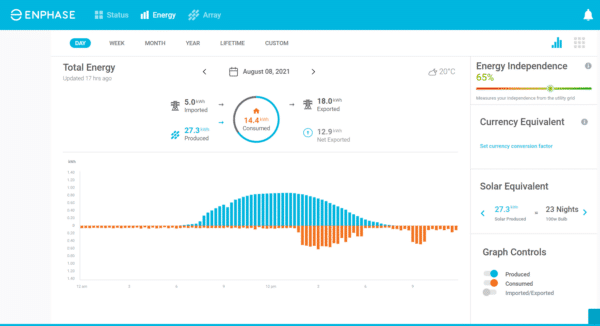
Then you get an electricity bill. It’s not terribly high, just slightly more than expected. Well, it is summer, and that air conditioning has been running a lot, so you don’t really think about it.
The next bill comes three months later, and it’s huge. Now, you’ve gone an entire quarter without a solar system cutting into your energy bills. How much money is that for your household? Is it over $1,000 per quarter?
It’s time to reach out to your solar installer. You call the sales company, but they don’t do maintenance and repair. They direct you to get ahold of the subcontractor who installed the system. How can you do that? Do you even remember their name? Can you find their business card? How long does this go on for? Another quarter, another billing period? Have you gotten another $1,000 energy bill?
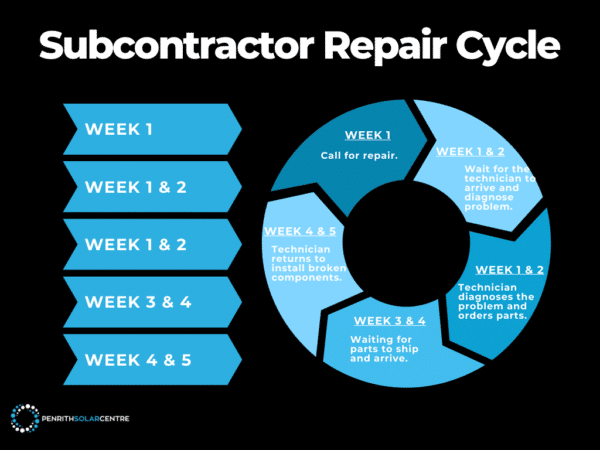
In six months, you’ve spent half the cost of your inexpensive string solar system. It’s not your fault though; you didn’t know it was malfunctioning and you couldn’t find who is responsible for fulfilling the warranty.
Brief Aside: We had a client walk into our showroom last week in a similar pickle. She asked if we service Solar Edge systems. The solar sales company that she bought the Solar Edge system from went under. She’s unable to track down the subcontractor who installed it. Solar Edge was not responding to her either.
The kicker was that her system was not broken, it did not need to be replaced. It was just in “night mode.” The string inverter thought it was nighttime for a couple of months while the nice lady was losing money to electricity bills while trying to track down anyone to help her and find out what the problem was.
Incidentally, if you’re interested in hearing about one installer’s experience working with an uncooperative solar sales company, you might want to check out this article posted by Mark Cavanagh of MC Electrical titled, SolarEdge Inverter and Optimiser Review.
Where were we? Oh, right: you’re in the third quarter of big energy bills again, and you finally look at the string inverter, right? The sales company tells you that they’re not responsible for replacing it, and the subcontractor finally comes out to look at the string inverter. He’s done his job 100% correctly, so it wasn’t an installation malfunction. He directs you back to the sales company because it’s faulty equipment. But the sales company is saying it’s his fault.
At this point, you’re so frustrated that you’re going to flex some muscle and make a fair-trade claim and see if you can get that warranty fulfilled. It can take up to 60 days to even hear back from them. That’s more time you’re paying a premium on your electricity bills. You’re well into your third quarter of this nonsense, around $3,000 in energy bills that solar isn’t helping with at all.
And this could potentially happen two more times with two more string systems that you’re going to have to replace to match the lifespan of a microinverter solar system.
If you’re interested in learning more about the differences between in-house installation companies like Penrith Solar Centre and sales companies that hire out subcontractors, you might want to check out the following article titled, In-house Installers vs. Subcontractors: Which is Better?
Find out about our installation process!
The Final Say, No Strings Attached
Now you know a few questions to ask your local string inverter solar system installer before you pull the trigger on a system. When you consider the upfront cost vs the payback period and whether or not you’re interested in enduring the subcontractor cycle of sadness, you might discover that microinverters are a pretty favourable option.
At Penrith Solar Centre, we’re here to guide you through your solar journey. Even though we only install microinverters, we understand that they aren’t the right option for everyone. We simply want you to be empowered to make the right choice for your energy needs.
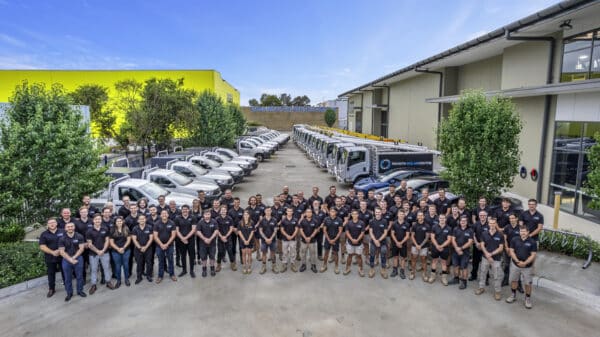
If you’re interested in learning more about string inverter solar systems, you might want to check out the following article titled, String Inverters vs Microinverters vs DC Optimiser: How Are They Different?


